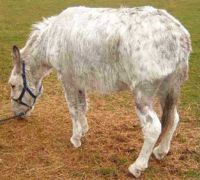Difference between revisions of "Bacterial Skin Infections - Donkey"
(No difference)
| |
Latest revision as of 08:39, 20 October 2010
Introduction

The common bacterial skin diseases include:
- Dermatophilosis
- Staphylococcal /Streptococcal farunculosis or folliculitis
- Fusobacterial dermatitis and infectious coronitis (F. necrophorum)
Mixed infections are common in donkeys and the limbs are probably more often affected than the body, but generalised dermatophilosis does occur and can be very difficult to treat.
The immune status of a donkey with extensive skin infections should be explored.
Clinical signs
Differentiation of the bacterial disease present can be possible on clinical grounds alone, but this is far more problematic in donkeys than in horses. Clinically it is sometimes possible to make an informed guess as to the bacteria involved. A very painful lesion will usually involve staphylococci, while a moderately painful lesion with closely adherent scabs will be streptococcal. Staphylococcal skin infection usually has less exudate whereas Dermatophilus may have more.
The distribution of the lesions associated with the various specific infections tends to be an indicator of the diagnosis. Thus, dermatophilosis affects areas most likely to be subjected to repeated damping (i.e. the back and the upper sides, head and lower neck) and produces focal lesions with a loose scab that leaves a florid, red base after removal. The lesion is characterised more by irritation than pain, but none of the bacterial skin diseases is usually pruritic.
Staphylococcal infection tends to be more diffuse (less well defined) in distribution but infection in donkeys is common on the limbs and the face.
Diagnosis
A major problem with bacterial skin disease is the tendency to mixed infections. Thus, a primary early streptococcal or dermatophilus infection can be complicated rapidly by staphylococcal overgrowth. Furthermore, secondary fungal infection can also complicate the diagnosis. Little is known about the normal bacterial flora of the donkey and it is certainly true that donkeys maintained in hot dry climates have less skin infection problems than those in damp, cool environments.
A specific diagnosis is important and this should be obtained by culture and if necessary biopsy (with or without deep biopsy culture). However, most cultures reveal a complex mixture of pathogens and opportunistic pathogens as well as commensals so it is often difficult to identify the main pathogen.
Treatment
Once the full spectrum of bacterial involvement is known, and the sensitivity profiles established, then rational treatment can be given. For the most part, however, bacterial infections will clear spontaneously with good hygiene, and exposure to sunlight can be very helpful.
One of the most important principles of management for bacterial dermatologic infections is to render the skin inhospitable to bacterial growth. A close ‘clip-out’ that exposes the base of the hairs to drying, sunshine or to antibacterial washes is helpful.
Repeated antibacterial washes that tend to macerate the skin through persistent wetting should be avoided. A single thorough wash following the manufacturer’s instructions is usually enough to set the reparative processes in motion.
Blankets, rugs and bandages should be removed as they simply increase the local exudation and macerate the skin still further. Furthermore, it is very easy to restrict capillary blood flow and so create a marginal, superficial (and occasionally deeper) necrosis of the skin. Ensuring that the skin remains dry and the donkey is given a healthy diet are important aspects.
Systemic antibiotics are a tempting option in the management of confirmed bacterial skin disease, but there is severe limitation in the delivery of the antibiotic to the surface of the skin or the hair follicles. For the most part, therefore, they should be avoided unless a single bacterial species is identified and the MIC can be reached at the site of the infection. This means that the clinician must understand the pharmacokinetics and delivery of the drugs chosen based on in vitro cultures and sensitivity.
Also, there is strong tendency to use steroid creams and lotions on focal skin infections. This should be avoided, not only because they seldom help but also because they may impair the local immunity and tend to cause skin thinning if applied frequently.
References
- Knottenbelt, D. (2008) Skin disorders In Svendsen, E.D., Duncan, J. and Hadrill, D. (2008) The Professional Handbook of the Donkey, 4th edition, Whittet Books, Chapter 8
|
|
This page was sponsored and content provided by THE DONKEY SANCTUARY |
|---|